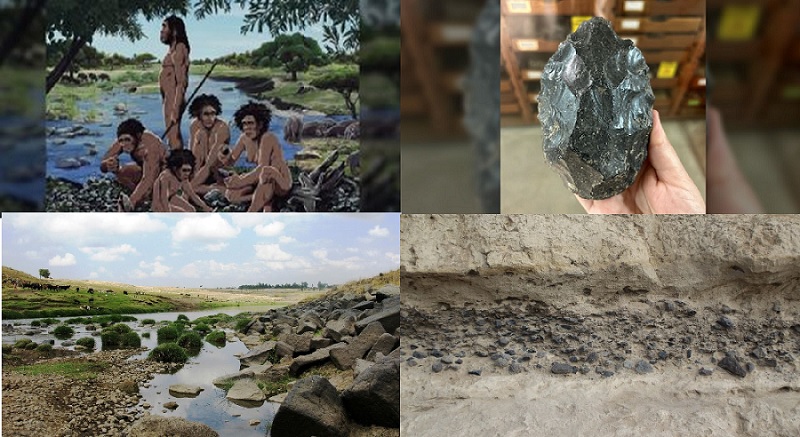
BY KFLEEYESUS ABEBE
Since the discovery of Lucy, the first Australopithecus afarensis skeleton ever found, Ethiopia has become a center of archeological studies. The discovery of other important archeological and paleontological milestones contributed the country to be called the land of origins. Archeological studies have persisted uncovering and informing on different aspects of early human life.
This week Live Science brought another development in archeological studies from Ethiopia. The magazine reads: More than 1.2 million years ago, an unknown group of human relatives may have created sharp hand axes from volcanic glass in a “stone-tool workshop.”
What is unique about the discovery is the place it is founded and the Tim becoming way older than previous record. Manufacturing of stone artifacts were previously recorded in France and England 500,000 years ago. But this discovery suggests that ancient human relatives may have regularly manufactured stone artifacts in a methodical way more than a half-million years earlier.
The finding offers a window into the evolution of the human kind than animals. This is due to the skill and knowledge requires. Stone tool used among early hominins, the group that includes humans and the extinct species more closely related to humans than any other animal.
A key advance in stone tool creation was the emergence of so-called workshops. At these sites, archaeologists can see evidence of hominins methodically and repeatedly crafting stone artifacts.
Margherita Mussi who is the study’s first author and director of the Italo-Spanish archeological mission at Melka Kunture and Balchit, a World Heritage site in Ethiopia, described the incident as: “This is very new in human evolution.” The newly analyzed trove of obsidian tools may be the oldest stone-tool workshop run by hominins on record.
Oldest known hominin workshop As Live Science, to come up with this finding the researchers investigated a cluster of sites in Melka Kunture, located along the upper Awash River valley of Ethiopia. The Awash valley is famous for yielding some of the best known examples of early hominin fossils, such as the famous ancient relative of humanity dubbed “Lucy.”
The scientists focused on 575 artifacts made of obsidian at a site known as Simbiro III in Melka Kunture. These ancient tools came from a layer of sand dubbed Level C, which fossil and geological data suggest is more than 1.2 million years old. These obsidian artifacts included more than 30 hand axes, or teardrop-shaped stone tools, averaging about 4.5 inches (11.5 centimeters) long and 0.7 pounds (0.3 kilograms). Ancient humans and other hominins may have used them for chopping, scraping, butchering and digging.
Obsidian proved far more rare at Simbiro III before and after Level C and scarce in other Melka Kunture sites. The new excavations also revealed that Level C experienced seasonal flooding, with a meandering river likely depositing obsidian rocks at the site during this time of Level C. Obsidian axes from this level were far more regular in shape and size, which suggests mastery of the manufacturing technique.
The archaeologists found an influx of obsidian at level C at the Simbiro III site, which suggests that an ancient river flooded periodically more than 1.2 million years ago, depositing obsidian there.
Ancient hominins “are very often depicted as barely surviving, struggling with a hostile and changing environment,” Mussi said in an email from the field in Melka Kunture. “Here we prove instead that they were clever individuals, who did not miss the opportunity of testing any resource they discovered.”
This nearly exclusive use of obsidian at Level C of Simbiro III is unusual during the Early Stone Age, which ranged from about 3.3 million to 300,000 years ago, the researchers said. Obsidian tools can possess extraordinarily sharp cutting edges, but the volcanic glass is brittle and difficult to craft without smashing. As such, obsidian generally only found extensive use in stone tool manufacture beginning from the Middle Stone Age, which ranged from about 300,000 to 50,000 years ago, they said.
John Hawks , a paleoanthropologist at the University of Wisconsin–Madison who did not take part in this research, validated the use of Odsidian saying: “The idea that ancient hominins of this era valued and made special use of obsidian as a material makes a lot of sense. Obsidian is widely recognized as uniquely valuable among natural materials for flaking sharp-edged tools; it is also highly special in appearance. Some historic cultures have used obsidian and traded it across distances of hundreds of miles.”
It remains uncertain which hominin may have created these artifacts. Previously, at other Melka Kunture sites, researchers have discovered hominin remains about 1.66 million years old that may have been Homo erectus, and fossils about 1 million years old that may have been Homo heidelbergensis, Mussi said. H. erectus is the oldest known early humanto possess body proportions similar to modern humans, whereas H. heidelbergensis may have been a common ancestor of both modern humans and Neanderthals, according to the Smithsonian.
Since the age of Level C at Simbiro III is more than 1.2 million years old, the hominins that made the obsidian hand axes there may have been closer in nature to H. erectus, Mussi said. The discovery is another proof that Ethiopia is indeed a land of origin and many discoveries are yet to come proving early civilization.
THE ETHIOPIAN HERALD FRIDAY 10 FEBRUARY 2023





